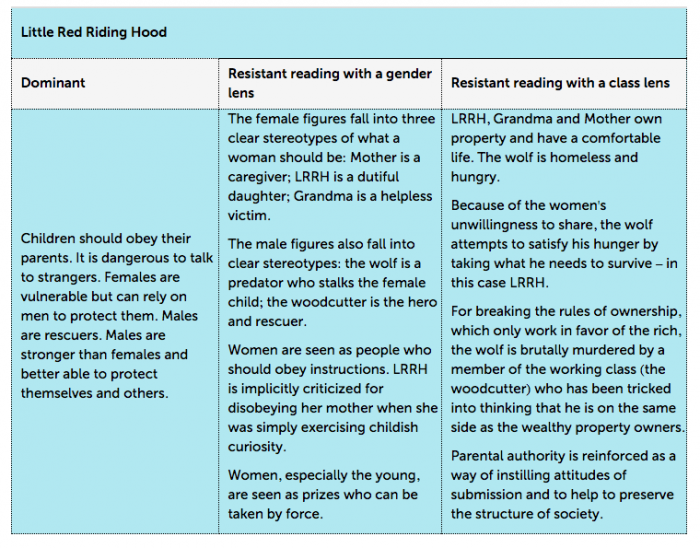Reading Against the Grain Historical Document Workshop
What?
In reading confronting the grain students analyze the dominant reading of a text and engage in culling or "resistant" readings. Resistant readings scrutinize the beliefs and attitudes that typically become unexamined in a text, drawing attention to the gaps, silences and contradictions.
When?
During reading and after reading
Why?
A "reading" refers to what nosotros believe the text ways; textual meaning is always dependent on context. A reader situated in a cultural context other than the one in which the text was written may detect meaning the writer did not intend. When students read confronting the grain, they learn to push back confronting the foregrounding and privileging of a dominant point of view (often heterosexual, non-disabled, Christian, white, or male). This strategy adds the experiences of less represented individuals and groups into the textual discourse.
Reading against the grain combines analysis, synthesis, evaluation and creation. Information technology also develops and assesses comprehension as students must sympathise the text to successfully engage in an alternative reading.
How?
Cull a cardinal text and program initial readings.
- Assess students' understanding of the text. Resistant readings must come after students achieve foundational comprehension.This includes an understanding of the text's central idea(southward) and how these ideas develop over the form of the text. Require students to thoroughly cite textual evidence in order to demonstrate their agreement. A shared reading lesson that uses questions from Challenge the Text is a good style to lead up to reading against the grain.
- Familiarize students with three ways of interpreting texts:
- Dominant readings are the most mutual and widely-accepted interpretations of a text. They embody the ascendant values and behavior in a culture and position the reader to favor the interpretation.
- Alternative readings are any readings that differ from—only do not claiming—the normally accustomed interpretation. Alternative readings are less common simply are easily accepted considering they practise not undermine the dominant reading.
- Resistant readings are culling readings of the text that claiming ascendant cultural beliefs and reject the position the text appears to offer. In that location are many different types of resistant reading. For instance, a feminist reading volition focus on how a text reinforces stereotypes about the role of women.
- Illustrate the 3 interpretations. A familiar story like Cinderella works well for this modeling exercise. Remind students that while the resistant interpretations are clearly not how we were meant to read Cinderella, these alternatives make sense when the story is read closely.
- Have students make up one's mind the author's indicate of view or purpose in the fundamental text. In add-on to describing the writer'due south view or purpose, students should apply textual evidence to explain how the author advances her ideas or claims. This stride sets upwardly students to be successful in the next step by requiring them to engage with the ascendant reading earlier considering other readings.
- Challenge students to produce alternative and resistant readings of thePerspectives primal text. During initial modeling, choose the "lens" for reading based on the lesson objective and the textual themes. (Click here for a sample resistant reading through the lenses of gender and form.) Selecting the lens becomes more difficult as text complication increases. Allow students to cull a lens that they find meaningful.
English linguistic communication learners
Reading against the grain is almost appropriate for highly good English linguistic communication learners. Exist certain to explain the origins of the expression "against the grain" and what it ways.
Connectedness to anti-bias education
Students not simply "try on other people's eyes" when they read against the grain, they also larn to read with an awareness of ability. Interpreting texts in this style helps students sympathize the social construction of knowledge and empowers them to question dominant beliefs and perspectives.
Sample A: Dominant and resistant readings of Cinderella
The ascendant reading of Cinderella presents an ideal image of romantic dear that survives confronting the odds. The prevailing message of this story encourages readers to believe that dreams can come truthful.
A resistant reading of Cinderella reveals the love interest to be a shallow homo who judges women solely on the footing of concrete attractiveness. A man who will ally a adult female on the ground of a few hours of dancing is probable to exit Cinderella if someone with daintier feet comes along. The story as well represents a woman's concrete appearance as a commodity for her to use to gain social status and wealth. The prevailing message cautions readers confronting believing in romantic love.
A feminist reading of Cinderella sees the heroine equally repressed and abused. To break costless of this repression she is forced to enter into a globe total of masculine power where she is appreciated for her ball gown and refinement. Further, her but hope to escape the shackles of domestic bondage relies on her power to seduce and ensnare a man. The prevailing message points out the misogyny inherent in the societal structures surrounding Cinderella.
Sample B: Comparison of dominant and resistant readings of Trivial Cherry Riding Hood

X
Add to an Existing Learning Plan
x
Welcome to Learning for Justice—Formerly Didactics Tolerance!
Our piece of work has evolved in the last 30 years, from reducing prejudice to tackling systemic injustice. So nosotros've chosen a new name that better reflects that development: Learning for Justice.
Acquire More
Source: https://www.learningforjustice.org/classroom-resources/teaching-strategies/close-and-critical-reading/reading-against-the-grain
0 Response to "Reading Against the Grain Historical Document Workshop"
Post a Comment